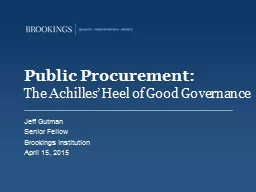

The Achilles Heel of Good Governance Jeff Gutman Senior Fellow Brookings Institution April 15 2015 Key Messages Public Procurement represents an important strategic instrument in the governance agenda and public policy It has helped promote open worldwide markets ID: 159936
Download Presentation The PPT/PDF document "Public Procurement:" is the property of its rightful owner. Permission is granted to download and print the materials on this web site for personal, non-commercial use only, and to display it on your personal computer provided you do not modify the materials and that you retain all copyright notices contained in the materials. By downloading content from our website, you accept the terms of this agreement.
Slide1
Public Procurement: The Achilles’ Heel of Good Governance
Jeff Gutman
Senior Fellow
Brookings Institution
April 15, 2015Slide2
Key Messages
Public Procurement represents an important strategic instrument in the governance agenda and public policy. It has helped promote open worldwide markets.
Fear of corruption has led to a debate between advocates for compliance versus those that argue for more discretion.
A results-based focus requires a different and more holistic approach to public procurement to best serve governance concerns for the quality of public expenditure while addressing governance concerns for integrity of the process.Slide3
BackgroundSlide4
Background
Public Procurement is the acquisition by government and related entities of goods, services, or works from an external source.
15-20% of GDP
U.S. Federal Level: 500
bn
/ year
WB: $7 billion & 100,000 contracts / yearSlide5
Background
“We are all procurement experts.”Slide6
Procurement and Aid FinancingSlide7
Principles of ProcurementEconomy and Efficiency
Equal opportunity to compete
Domestic contracting
TransparencySlide8
Procurement and Aid Financing
International Competitive Bidding
National Competitive BiddingSlide9
Procurement and Aid Financing
Development of a worldwide competitive marketSlide10
Top 10 Suppliers for Foreign Procurement (by value of contracts)
Sources: World Bank Annual Report 1985; World Bank Borrower Procurement Reports
1980s
1995
2005
2013
United States
United States
China
China
Japan
Japan
France
Italy
Germany
Italy
Germany
Spain
United Kingdom
Germany
United Kingdom
India
France
France
Spain
France
Italy
China
Saudi Arabia
United States
Switzerland
United Kingdom
Austria
Denmark
Canada
Korea, Rep.
India
Turkey
Netherlands
Spain
Singapore
Venezuela, RB
Korea, Rep.
Norway
Malaysia
SwedenSlide11
# of ICB Contracts by Supplier Country
1995
Source: World Bank Annual Procurement Reports – excluding Consultant Services & Non-ConsultantSlide12
# of Contracts by Supplier Country
2013
Source: World Bank Annual Procurement Reports – excluding Consultant Services & Non-ConsultantSlide13
Procurement and Aid FinancingImpact on Local Industry
Stages of Development
Serving small local market
Competing for ICB within country
Competing regionally
Competing globallySlide14
Procurement and Aid FinancingImpact on Local Industry
Share of Regionally Supplied Civil WorksSlide15
The Compliance versus Discretion DebateSlide16
The Compliance v. Discretion Debate
Stylized Formula
C = M + D – A
C: Corruption
M: Monopoly
D: Discretion
A: Accountability
Source:
Klitgaard
(1998)Slide17
The Compliance v. Discretion DebateThe Case for Compliance
Clarity of process and criteria essential
Worldwide perception of substantial corruption
EU Report
OECD Report
Developing countries’ weak institutions
“Zero Tolerance”Slide18
The Compliance v. Discretion DebateThe Case for Discretion
Role of professional judgment and adaptability
Excessive role of the contract officer
Risk-averse culture
Innovation and creative solutions
Value-for-Money versus Price-only criteria
Horizontal objectivesSlide19
Towards a Practical ResolutionSlide20
Towards a Practical ResolutionWhat needs to be done
It is crucial that we look at development effectiveness of procurement in terms of the actual project or contract outcomes/resultsSlide21
Frequency of Procurement Topics Raised During World Bank Consultations
Source: World Bank Procurement Policy Review: Feedback from Consultations with External StakeholdersSlide22
It is crucial that we look at development effectiveness of procurement in terms of the actual project or contract outcomes/results
If the focus is on final outcomes, then the focus must be on the whole procurement cycle from design, to bid/award to contract management/implementation
Towards a Practical Resolution
What needs to be doneSlide23
Stages of the Procurement CycleSlide24
It is crucial that we look at development effectiveness of procurement in terms of the actual project or contract outcomes/results
If the focus is on final outcomes, then the focus must be on the whole procurement cycle from design, to bid/award to contract
management/implementation
Looking at the whole procurement cycle and the
Klitgaard
corruption model, identify the risks of each stage
Towards a Practical Resolution
What needs to be doneSlide25
C = M + D – A
C: Corruption
M: Monopoly
D: Discretion
A: Accountability
Source:
Klitgaard
(1998)Slide26
It is crucial that we look at development effectiveness of procurement in terms of the actual project or contract outcomes/results
If the focus is on final outcomes, then the focus must be on the whole procurement cycle from design, to bid/award to contract
management/implementation
Looking at the whole procurement cycle and the
Klitgaard
corruption model, identify the risks of each
stage
A key factor in ensuring credible use of discretion is for public policy professionals to better understand procurement as a public policy strategy instrument
Towards a Practical Resolution
What needs to be doneSlide27
“One man’s ‘red tape’ may be another’s treasured safeguard”
−
Herbert Kaufman